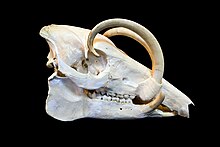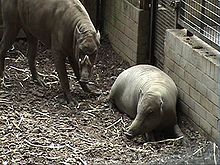Buck boar
| Buck boar | ||||||||||||
|---|---|---|---|---|---|---|---|---|---|---|---|---|

Sulawesi deer boar ( Babyrousa celebensis ) |
||||||||||||
| Systematics | ||||||||||||
|
||||||||||||
| Scientific name | ||||||||||||
| Babyrousa | ||||||||||||
| Perry , 1811 |
The Hirscheber ( Babyrousa ), also babirusas called, are a mammalian species from the family of Real pigs (Suidae). They only live on Sulawesi and the offshore islands and are known for their long, trunk-breaking tusks. While all animals used to be grouped into one species , today a distinction is made between four species, including one that is extinct.
Surname
Although the word “boar” usually means a male pig, both sexes of this species are mentioned here. The name Babirusa is a combination of the Indonesian words for "deer" and "pig".
features
The most striking feature of the deer boars is their tusks , which are larger than any other pig. The upper tusks do not grow out of the mouth, but straight up; they break through the trunk cover and then grow in an arc until they reach their starting point again. Sometimes the tips of the tusks grow back into the skin and flesh of the trunk. The total length of these teeth in males can reach over 30 centimeters. Females have much shorter tusks. In contrast, the tusks of the lower jaw grow to a shorter length. They also grow upwards, but protrude laterally from the mouth. In rare cases they can grow forward like a dagger. Due to the frequent fights between the males, deer boars with broken tusks are very common in the wild.
Deer boars have a head body length of about 88 to 107 centimeters, the tail is an additional 28 to 32 centimeters long. The shoulder height is 65 to 80 centimeters, the weight up to 100 kilograms. The skin, which is only sparsely covered with bristle hair, is gray-brown on the top and whitish on the underside, with the white extending to the lips. The skin often wrinkles on the neck and stomach. The body appears rounded and the legs are relatively long and thin.
distribution and habitat
Deer boars are endemic to the Indonesian island of Sulawesi and offshore islands such as the Togian Islands . One kind lives on the Moluccas -Insel Buru ; but it was evidently brought here by humans. Habitat is the tropical rainforest .
Way of life
Deer boars are diurnal and look for food especially in the morning. To get ahead faster, they create trails in the thick undergrowth. Animals in captivity build straw nests to sleep on, but it is not known whether this behavior also applies to animals living in the wild. They live in groups of up to eight animals, mostly consisting of females and their offspring. The males often live solitary.
Their tusks do not allow them to dig in the ground like pigs, so that they eat leaves and fallen fruit.
Reproduction
During the mating season, males fight violently for the right to mate with a female. Injuries are rare, however, as the tusks usually point backwards. The female can give birth to offspring twice a year. The gestation period is around five months, the litter size one or two. In contrast to most pigs, newborn stag boars are not striped, they are decidedly fleeing nests and can already eat solid food 10 days after birth. Sexual maturity occurs after five to ten months. The highest recorded age of animals in captivity is 24 years.
Deer boars and people
Deer boars have always been hunted and tamed by the inhabitants of Sulawesi . However, real domestication has never taken place, since the captured animals usually do not reproduce. 39,900 year old cave paintings near Maros in the south of Sulawesi, Indonesia, depict deer boars.
The wild population is now estimated at 4000 animals and classified by the IUCN as endangered ( vulnerable ) or endangered ( endangered ) depending on the species .
The deer boar is the only known mammal in which a tooth regularly breaks through the skin. However, inflammatory infections never occur in these areas. Deer boars are therefore also a target of medical research that wants to find out what causes this insensitivity. The findings could be useful in medical technology .
In August 2006, four deer-Danish domestic pig hybrids were born at Copenhagen Zoo. Common offspring are very unlikely because of the extensive relationship and, apart from this case, have not yet been scientifically documented.
Systematics
As mentioned at the beginning, four recent species of deer boar are distinguished today. However, this classification must be considered provisional as no detailed genetic tests have yet been carried out.
- The Moluccan deer boar ( Babyrousa babyrussa ) is native to the island of Buru and the nearby Sula Islands . Since these islands do not belong to the original range of the animals, they are probably the descendants of an unknown species that became extinct on Sulawesi itself.
- The Sulawesi deer boar ( Babyrousa celebensis ) is the only species that lives on Sulawesi itself today.
- The Togian deer boar ( Babyrousa togeanensis ) lives exclusively on the Togian Islands .
- A form known only from bone finds , Babyrousa bolabatuensis, was widespread in the Holocene in southwest Sulawesi , but is likely to have died out. From the Pleistocene , another form B. ( b. ) Seinensis has been described.
literature
- Ronald M. Nowak: Walker's Mammals of the World . Johns Hopkins University Press, Baltimore 1999, ISBN 0-8018-5789-9
- DE Wilson, DM Reeder: Mammal Species of the World . Johns Hopkins University Press, 2005, ISBN 0-8018-8221-4
- IUCN / SSC Pigs and Peccaries Specialist Group (1993): Status Survey and Conservation Action Plan. Pigs, Peccaries, and Hippos. Edited by William LR Oliver. IUCN, Gland Switzerland, ISBN 2-8317-0141-4
- B. Funck: The deer boar . In: The Gazebo . Issue 1, 1882, pp. 18 ( full text [ Wikisource ]).
Individual evidence
-
↑ M. Aubert, A. Brumm, M. Ramli, T. Sutikna, EW Saptomo, B. Hakim, MJ Morwood, GD van den Bergh, L. Kinsley, A. Dosseto: Pleistocene cave art from Sulawesi, Indonesia. Nature 514, Oct. 9, 2014; Pp. 223–227, doi: 10.1038 / nature13422
David Cyranoski: World's oldest art found in Indonesian cave . nature.com , October 8, 2014, doi: 10.1038 / nature.2014.16100 , accessed on January 31, 2018 (with video of the cave paintings; English).
David Cyranoski: Indonesia: The oldest human art . Spiegel Online , October 8, 2014, accessed January 31, 2018. - ↑ E. Meijaard, JP d'Huart, WLR Oliver: Babirusa. (Babyrousa) In: DE Wilson, RA Mittermeier (Ed.): Handbook of the Mammals of the World. Vol. 2: Hoofed Mammals. 2011, ISBN 978-84-96553-77-4 , pp. 274-276.
- ↑ Babyrousa togeanensis in the IUCN Red List of Threatened Species 2011.2. Listed by: Macdonald, AA, Burton, J. & Leus, K., 2008. Retrieved November 4, 2012.
- ^ Alastair A. MacDonald: Chapter 5.8: The Babirusa (Babyrousa babyrussa). In: IUCN / SSC Pigs and Peccaries Specialist Group (1993): Status Survey and Conservation Action Plan. Pigs, Peccaries, and Hippos. Edited by William LR Oliver. IUCN, Gland Switzerland, ISBN 2-8317-0141-4
Web links
- Babyrousa babyrussa in the endangered Red List species the IUCN 2006. Posted by: Pigs & peccaries Specialist Group, 1996. Retrieved on 5 May, 2006.
- Report on deer-boar-domestic pig hybrids
- Protection project for the deer boar of the ZGAP




